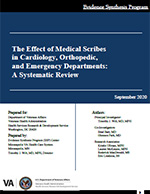
|
Prepared by: Recommended citation: |
Download PDF: Complete Report, Executive Summary, Report, Appendices
Medical scribes are individuals who assist clinicians with day-to-day tasks including recording and documenting information in real-time during patient visits. In addition to documenting medical visits, medical scribe duties include communicating with patients and completing clerical tasks; verifying and correcting mistakes or inconsistencies in medical records; collecting, organizing, and cataloging data for clinicians; and attending practice-related training. Integrating medical scribes with clinicians is suggested to improve access, quality and timeliness of care, enhance patient and clinician satisfaction and increase productivity and health system revenue.
Medical scribe use has increased markedly in the past 10 years, in part, due to implementation of Electronic Medical Records (EMRs) required by legislation. In 2009 the Health Information Technology for Economic and Clinical Health (HITECH) Act, part of the American Recovery and Reinvestment Act (ARRA), was enacted and required meaningful use of health information technology. These acts created a large demand for electronic data entry by clinicians as well as an increase in documentation requirements for billing and reporting initiatives.
EMRs provide important advantages, such as structural and process-related benefits6 and enhanced patient care. However, EMRs increase the burden of clinical documentation, disrupt face-to-face patient encounters, and reduce time available for resident and student training. Additionally, efficiency measures required by the quality reporting program enacted by the Centers for Medicare & Medicaid Services, such as door-to-doctor time or length of stay, has increased pressure on clinicians and health systems to meet these quality metrics.
While formal training, accreditation, and recertification are not required for all scribe positions, there are 2 scribe accreditation programs available in the United States. In addition to "in house" training, health care systems or individual clinical groups can hire outside companies to train, accredit, place, and conduct performance evaluations of scribes and accompanying documentation through contracting mechanisms. These companies can reduce administrative hiring, training, and oversite burden and serve as a resource to replace scribes that have relatively high turnover. Additionally, these companies can also contract for "virtual scribes" whereby the scribes are located "off-site" and conduct their duties through video teleconferencing.
Within the Department of Veterans Affairs, the 2018 MISSION Act aimed to increase Veterans' access to health care. Section 507 of the MISSION Act12 mandates a 2-year pilot of in-clinic medical scribes in VA specialty clinics and emergency departments to evaluate clinician efficiency, patient volume, and patient satisfaction. With insight from our Operational Partners and Technical Expert Panel members, we conducted a systematic review of medical scribes focused on outpatient emergency, cardiology, and orthopedic departments. The Section 507 Committee will use the findings of this review to inform the use of medical scribes in the VA.
Key Question 1: What is the effect of medical scribes in cardiology, orthopedic, or emergency department clinics?
Key Question 2: How do the effects of medical scribes vary based on differences in compensation structure (ie, contracted through vendor or employees of the institution), qualifications (ie, training, accreditation, experience), types of entries (ie, medical orders, medical history, coding [billing, diagnoses, complexity/comorbidities]), or setting (ie, rural, urban, access-challenged)?
The Effect of Medical Scribes in Cardiology, Orthopedic, and Emergency Departments: A Systematic Review (Management eBrief)
Ullman K, McKenzie L, Bart B, et al. The Effect of Medical Scribes in Emergency Departments: A Systematic Review. Journal of Emergency Medicine. Published online May 16, 2021. doi: https://doi.org/10.1016/j.jemermed.2021.02.024.